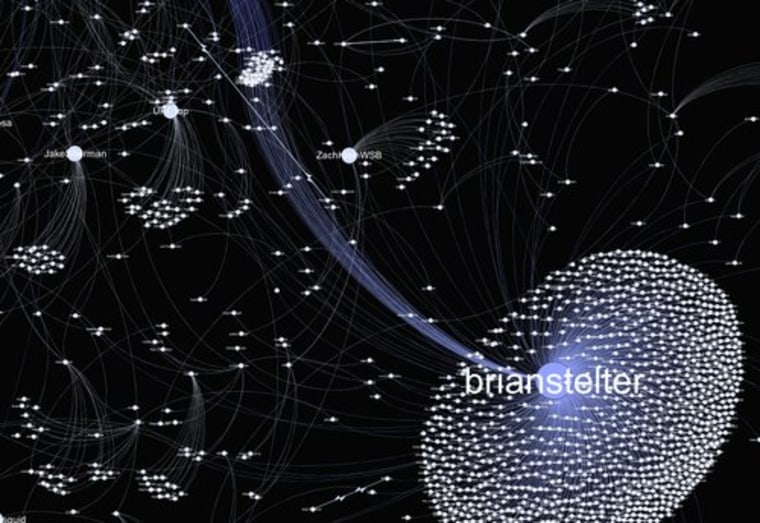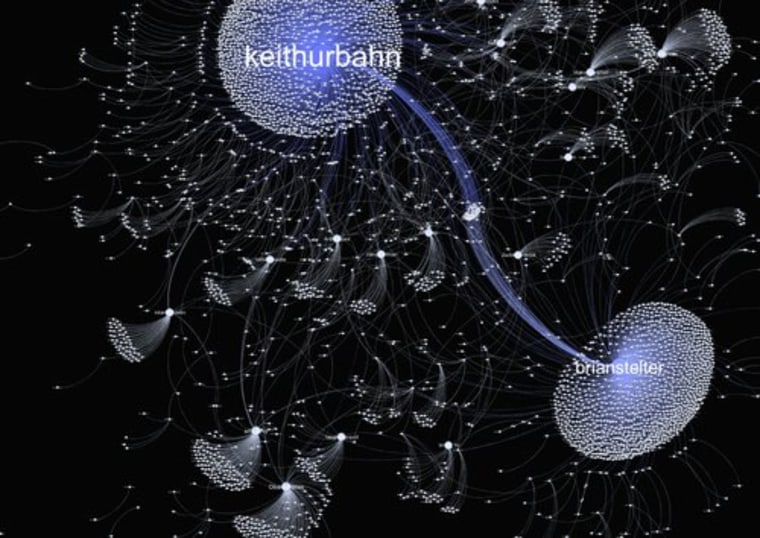For many on May 1, the news of Osama bin Laden's death came not from the president's TV address to the nation, but via Twitter, where millions of tweets speculating about the announcement and Public Enemy No.1's rumored demise circulated for hours.
Turns out, one guy had the Twitter scoop on bin Laden's death, and it wasn't the guy who liveblogged the raid.
SocialFlow analyzed 14.8 million public Tweets, and bitly links, "posted between news about an unplanned presidential address (9:46 p.m. EST) and Obama’s address (11:30 p.m. EST) to see how dynamics of rumor creation played out during those critical hours on Twitter."
What they found — and illustrated through the almost celestial looking visualizations above and below — was that @keithurbahn aka Keith Urbahn, Chief of Staff at the office of Donald Rumsfeld, who a week ago had a little over 1,000 followers (which is respectable, but by no means a guaranteed viral indicator) set off a cascading domino effect with one tweet: "So I'm told by a reputable person they have killed Osama Bin Laden. Hot damn."
Before his tweet, which clocked in at 10:24 EST, conversations were flying on Twitter. SocialFlow provides some excerpts, which show bin Laden was definitely on the minds of many, and at the very least, they knew something big was about to break.
Urbahn (not to be confused with the country singer husband of Nicole Kidman) hit a tweeting goldmine, as described by SocialFlow:
Within a minute, more than 80 people had already reposted the message, including the NYTimes reporter Brian Stelter. Within two minutes, over 300 reactions to the original post were spreading through the network. These numbers represent the people who either retweeted Keith’s original message, or posted a reaction to it. The actual number of impressions (people who saw Keith’s message in their stream but didn’t repost it) is substantially higher.
Stelter (aka @brianstelter) was the next big pinpoint of the Twitter effect. With 50,000 followers (now almost 56,000), Stelter "engaged his audience and yielded hundreds of retweets, furthering the spread of this message," which you can see in the visualization below.

SocialFlow zoomed in on a few of Stelter's followers to see how they retweeted his message and engaged their followers, so the information kept going in this evolved form of telephone.
Gilad Lotan and Devin Gaffney, who posted on SocialFlow's blog from its Research and Development team, concluded with these observations:
Authority, trust and persuasiveness play an important role in influencing others, but are only part of a complex set of dynamics that affect people’s perception. Connections are another important factor, along with timing and a dash of pure luck. But as humans, we are still incredibly irrational, and constantly make decisions based on our intuition, or whatever we feel like at that moment ... Keith Urbahn wasn’t the first to speculate Bin Laden’s death, but he was the one who gained the most trust from the network. And with that, the perfect situation unfolded, where timing, the right social-professional networked audience, along with a critically relevant piece of information led to an explosion of public affirmation of his trustworthiness.
Urbahn's Twitter world boomed this week with this news: he's now got more than 8,100 followers.
Twitter said that evening saw the highest sustained rates of Tweets ever," from 10:45 p.m. ET Sunday to 12:20 am., with Twitter averaging 3,000 tweets per second during that time." "At exactly" 11 p.m. ET Sunday, "there were 5,106 tweets per second," and at 11:45 p.m. ET, when the president finished his remarks, there were 5,008 tweets per second.
Google also announced a staggering one million percent increase in searches on bin Laden on May 1.
All this curiosity about bin Laden did not come without consequences, however: viruses and scams have run rampant since last week, attacking vulnerable rubber neckers everywhere who couldn't resist finding out more or clicking on those nasty death photos. (Don't worry, we're linking you to our story, not to the photos!)
More stories:
- Twitter on Osama: 'Highest sustained rates of Tweets ever'
- Bin Laden's death unites Internet town square
- Kids react to Osama bin Laden's death
Check out Technolog on Facebook, and on Twitter, follow Athima Chansanchai, who did not find out about the president's address or bin Laden's death through Twitter.
